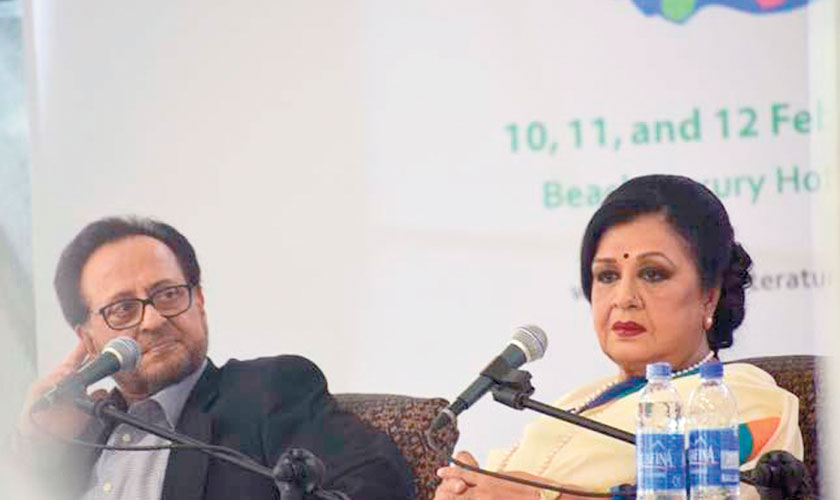Veteran actor Shabnam, who ruled millions of hearts for over two decades, is finally coming back to the silver screen after a long stretch of absence.
Introspective
With veteran actor Shabnam all set to return to the silver screen, Instep looks back at her lasting legacy.
Veteran actor Shabnam, who ruled millions of hearts for over two decades, is finally coming back to the silver screen after a long stretch of absence.
From 1970 till the late 1980s, she was the one actor whose presence in a film ensured its fate. Her pairing with co-star Nadeem Baig not only resulted in the birth of several hit films but also led to cross-border imitation in the aftermath of their success.
Pakistani films are nowhere close to where they used to be during Shabnam’s heydays. But a sequel to M. A. Shamsi’s blockbuster Aaina, announced in Karachi recently by veteran filmmaker Syed Noor - who plans to helm it - could change all that, temporarily at least.
As the adage ‘Rome was not built in a day’ goes, the same can be said for Shabnam; she didn’t find stardom overnight but spent several years working extremely hard before her transformation to a superstar occurred. She worked hard in a way that this generation cannot fathom.

A legendary pairing: The graceful Shabnam made her presence felt when she attended the Karachi Literature Festival earlier this year, seen here with Nadeem Baig.
In August 1962, the first full-length Urdu feature film from East Pakistan, Chanda was screened in cinemas. Director Ehtesham presented a pleasant girl Jharna as ‘Shabnam’ in a side role in the first Urdu film from East wing.
It was a sleeper hit. Shabnam and Subhash Dutta got Nigar Awards for their performances that year. In 1963, Saeed Fazli, son of director/producer Fazal Karim Fazli went to Dhaka to release Chiragh Jalta Raha and met Shabnam and Robin Ghosh with the latter having composed the music of Chanda. The success of ‘Chanda’ had already made them stars. Saeed was among the first to advise them to work in West Pakistan.
With hits like Mustafeez’s Talaash, Nazrul Islam’s Kaajal and Ehtesham’s Paisay, Shabnam became just as famous in West Pakistan. She could have been the best but Urdu language was ‘alien’ to her. But despite her struggle with Urdu dialogue delivery in Nazrul-Islam’s Kaajal, she managed to survive.
During this crucial juncture in her career, she was helped by the great poet Suroor Barabankvi. Suroor sahib, a lyricist, script writer and later a film maker had mentored many Bengali actors and directors with proper Urdu diction.
Suroor Barabankvi’s maiden venture, Aakhri Station, helped Shabnam in registering her name as a top actor of the country. Released in December 1965, Shabnam played the role of an intellectually disabled girl in the venture.
Still weak in Urdu, she had dialogues as good as none, but it was a performance backed by many expressions.
A low budgeted film based on Hajra Masroor’s story, became a hit, and Shabnam became a household name. She still considers the role the best in her decades long career.
After getting married around the time of the release of Aakhri Station, Mr. and Mrs. Robin Ghosh decided to come to West Pakistan. Shabnam was cast alongside Waheed Murad, the biggest name in the film industry back then, in Rafiq Rizvi’s Anjaanay Raastay. With Zeba getting married to Muhammad Ali, Shamim Ara turning to production and Rani still a year away from achieving greatness, Shabnam seemed like the perfect person to fill the top slot. However, Anjaan Raastay, was not released and West Pakistanis had to wait.
Waheed Murad, in the meantime, decided to produce Samandar, which was (slightly) based on the political scenario.
“It was a subject for which my father wanted the heroine from East Pakistan. So Shabnam was roped in,” Masood Rizvi, associate director of Samandar and son of the director Rafiq Rizvi, aka Bapu, recalls from his home in Lahore.
Shabnam had to prove herself in front of the West Pakistanis. Samandar did not click and Shabnam was partly responsible. On her arrival in West Pakistan, she signed many films including Rashid Mukhtar’s Andaleeb. Mukhtar was taking a chance on director Saeed Fazli’s insistence, when suddenly Samandar drowned.
“Reports came from Karachi that whenever Shabnam delivered her dialogues, hooting began. Her ‘Bengali’ accent was unacceptable to the audience of a West Pakistani movie. Rashid was furious at me and all of us including Nisar Bazmi and Faird Ahmed sat down to find a solution,” recalls an 82-year-old Saeed Fazli, who was clueless about how to re-launch Shabnam.
Andaleeb was to be made in color, but out of the blue, a certain Kaukab Afzal knocked on the door. A 30-something beautiful woman, Kaukab Afzal and her husband, would regularly visit the office of Saeed Fazli in Lahore for work.
“Kaukab Afzal would always announce her presence with a ‘May I come in Sir’ and it made me think of Shabnam. Suddenly I decided to dub Shabnam with Kaukab’s voice,” elaborated Fazli further.
Andaleeb went on to become a hit. With the passage of time, Shabnam improved her diction, but those things were rarely noticed and she was accepted by the people. The 1970s and 1980s truly belonged to her. Her dialogue delivery became a style and her way of draping a sari, a rage.
Syed Noor has made money-making films in the past, but none of them can be deemed classic(s). As for sequels, they don’t have a particularly strong legacy of turning out well, at least in this part of the world.
By choosing Shahroz Sabzwari, a celebrated TV actor with limited film experience, Noor is planning to resurrect the careers of Shabnam, the young man that is Shahroz, his own legacy and the industry at large. Miracles do happen, but lately, Pakistan’s film industry has seen none. Time will tell whether this miracle will bear any fruits.